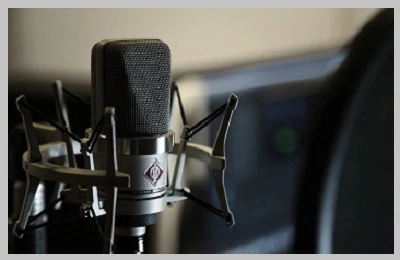As a sound tech, you may be wondering how do condenser and microphones compare? While both types of microphones are designed to capture audio, they each have unique features that make them better suited for different applications. In this blog post, we’ll explore the key differences between condenser vs dynamic microphones so that you can make an informed decision about which type is right for you.
How do dynamic mics work?
Dynamic microphones are the go-to choice for professional audio applications. The dynamic microphone is unique in its design, working on the principle that a coil of wire around a magnet receives sound vibrations and translates them into electrical signals. This dynamic microphone uses more than just one diaphragm to facilitate greater accuracy and sensitivity when recording and preserving sound; it consists of an outer and inner diaphragm combined with a transformer which can help amplify very low level signals.
the pressure from a sound wave hits the dynamic mic’s diaphragm, it causes changes in current through the winding coils surrounding the magnet, sending out audio signals that can be amplified or reproduced by an amplifier or mixer. These mics are incredibly versatile and are used in shooting music videos, radio broadcasting and studio recording sessions.

Dynamic mics are typically used for recording instruments like drums, guitar amps, and vocals due to their ability to capture loud sounds without distortion—a trait known as high SPL (sound pressure level) handling. Additionally, these mics often come with built-in shock mounts which help reduce unwanted noise from handling or vibration noises from other instruments/speakers near them and are great for all kinds of recording environments.
Advantages
The main advantage of using a dynamic microphone is its simplicity: because they don’t require any additional phantom power sources or batteries, they can be quickly set up and used without needing any extra equipment or technical knowledge. Additionally, these mics are incredibly durable; they don’t need much maintenance beyond occasional cleaning and they can withstand high volumes without suffering too much damage over time.
Also, because they have a more limited frequency response than condenser microphones (the other type of popular studio mic), they are better at rejecting ambient noise while still delivering clear audio signals with low self-noise levels, while at the same time producing good sound reproduction.
How do condenser mics work?
A condenser mic is an electro-acoustic transducer that converts sound into an electrical signal. It works by using a capacitor, which is made up of two plates, one fixed and one moveable. The moveable plate is known as the diaphragm. When sound waves hit the diaphragm, it vibrates, which causes fluctuations in capacitance (the ability to store energy) between the two plates. These fluctuations are then converted into an electrical signal by a preamplifier. A condenser microphone generally will need phantom power to make it work.
Most mics use dynamic capsules, which work by having a coil attached to the diaphragm that moves within a magnetic field when sound hits it. The coil then produces an electrical current when it moves back and forth in response to changes in pressure caused by sound waves hitting it. In contrast, condenser mics use capacitors instead of coils and magnets to convert sound waves into electrical signals.
This makes them much more sensitive than other types of mics, allowing them to capture even subtle nuances in sound with amazing accuracy and sound quality.

Large and small diaphragm condensers
Large diaphragm condensers are characterized by their size and sensitivity. The term “large diaphragm” refers to the fact that they have larger transducers than small diaphragms. This means that they are able to capture sound more accurately than small diaphragms since they have a larger surface area to work with when picking up sound.
Furthermore, these mics tend to be more sensitive than their small counterparts, allowing them to pick up quiet sounds more easily. They are also good at capturing low-frequency sounds like basslines or drums. Because of their frequency response, accuracy and sensitivity, a large diaphragm condenser is ideal for recording acoustic instruments and recording vocals as well as capturing ambient noise in a room or studio space.
In contrast to large diaphragms, small diaphragm condenser mics have smaller transducers that can pick up higher frequencies more accurately than larger mics. That being said, they aren’t as good at picking up lower frequencies as their bigger counterparts. Smaller mics also tend to be less sensitive than large ones, so if you need something that can pick up softer sounds then a large one is probably your best bet.
That being said, if you’re looking for something versatile then a small one might be the way to go since it will be able to capture both high-pitched instruments such as cymbals or hi-hats as well as lower pitched instruments like basslines or kick drums.
Advantages
Due to their superior level of accuracy and sensitivity, condenser mics are highly sought-after for recording music and speech alike. They also tend to be much smaller than dynamic mics due to their lack of magnets and coils, making them easier to transport and use in tight spaces.
Additionally, they often have built-in preamps that allow for greater control over the signal coming out of them, but they do require an external power supply. All these factors make them extremely popular among musicians and audio engineers alike!
How do both mics compare when used for vocals?
The main difference between a dynamic mic vs condenser mic is sensitivity to sound. Dynamic mics are less sensitive and therefore require more power to pick up sound. This makes them ideal for live performances, as they can handle louder sounds without distortion. However, because they aren’t as sensitive, they don’t capture subtle nuances in the vocalist’s performance as well as a condenser mic would.
On the other hand, condenser mics are much more sensitive than dynamic mics – so much so that some can pick up even the slightest sound from across a room. This sensitivity makes them ideal for studio recordings, as they can pick up highly nuanced performances with greater accuracy. However, since they’re so sensitive, they’re also prone to picking up unwanted background noise – something that can be an issue in live settings.
Which Is Better For Vocals?
The answer to this question depends on where you plan on using it: a dynamic mic are best suited for live performances while condenser mics are better suited for studio recordings. That being said, there are some dynamic mics that can be used in studio settings if you want a slightly more “natural” sounding vocal take – just keep in mind that these mics will require more power to get the same level of performance out of them as a condenser mic would.
How do these microphones compare in the studio?
For working in the studio, condenser and dynamic microphones each have their purpose. Condenser mics are typically used for capturing high-frequency sounds, which makes them a great choice when you’re recording acoustic instruments, vocals, and similar instruments that require clear details and excellent sound quality.
On the other hand, a dynamic microphone works best in situations with loud volumes or a lot of bass, such as electric guitar amps or drums. They also produce signals that retain plenty of clarity but without boost any frequency too much.
Ultimately, it all boils down to picking the right tools for the job; condensers are great when you need accurate representation of sound sources with lots of details, while dynamic mics are better suited for capturing loud sounds and delivering good results despite higher levels of background noise.
Which is best for live performance?
If you’re looking to produce a great live performance, picking the right microphone is essential. When it comes to condenser versus a dynamic microphone, many people swear by one or the other. With condenser mics, which require power for their condenser to activate, you’ll get clearer sound and high alteration levels that make the most of vocals in a concert setting.
On the flip side, dynamic mics are more hardy and longer-lasting but don’t offer quite as much clarity as condenser versions. Ultimately it’s up to personal preference — condenser mics are great if clarity is key for your performance, while dynamics provide more durability for busy tours across venues.
Conclusion
-Dynamic microphones are ideal for high sound levels. They’re also more durable than condenser microphones.
-A Condenser microphone is more sensitive and requires a power source, making it first choice for recording in many situations. However, they’re also more liable to break than dynamic microphones.
-Both types of microphones have their own advantages and disadvantages, so it’s important to choose the right one for your needs.
-If you’re not sure which type of microphone to get, ask a professional or do some research online. There are plenty of resources available that can help you make the right decision.
-Remember that the most important thing is to find a microphone that sounds good to you and suits your needs.

Leave a Reply